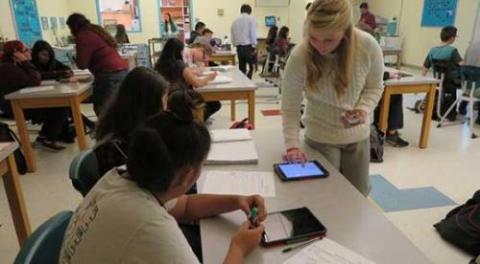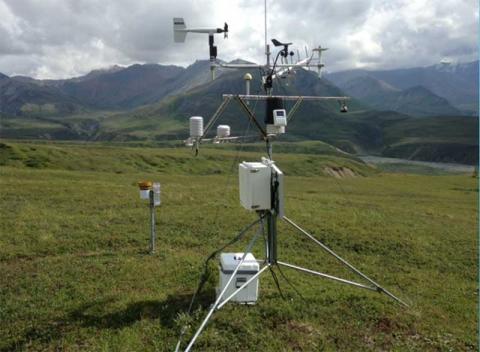Let’s Learn About Weather and Climate Science
An experiential and inquiry-based unit of instruction designed to improve science comprehension of middle school students in weather and climate.

Students using I-Pads to access the NOAA Regional Climate Centers database (Lessons 3 and 4)
Introduction
The “Let’s Learn About Weather and Climate Science” unit of instruction was designed to improve science comprehension of middle school-aged youth in weather and climate. Over a 2 week period, the five lessons will teach youth about the water cycle, the greenhouse effect, how to access local weather station data in the NOAA Regional Climate Centers database to study precipitation and temperature trends, and the concepts of mitigation, adaptation, and resiliency to weather and climate extremes. All of the lessons are framed by the authors’ science comprehension model (Figure 1).
Figure 1. New Mexico State University Youth Agricultural Science Center (YASC) Comprehension Model (Skelton, Dormody, & Lewis, 2016; Skelton, Seevers, Dormody, & Hodnett, 2012).

The basic premise for the model is that when students engage in inquiry-based and experiential lessons designed to improve science knowledge, science skills, and science reasoning abilities in a content area, their science comprehension will grow. With each additional lesson developed and taught by integrating the five model-supporting elements, science comprehension will widen, emulating a learning tornado over time (Skelton, Dormody, & Dappen, 2016). Hence, the weather and climate science lessons, provided to middle school-aged youth educators here, all integrate the five supporting elements of the science comprehension model.
The lessons are aligned with grade level appropriate Next Generation Science Standards (n.d.) and Agriculture, Food, and Natural Resources Content Standards and Benchmarks for New Mexico (Castillo, 2003) which are used by teachers in New Mexico where the curriculum was developed. Other resources accompanying the curriculum are worksheets and a PowerPoint slide set for each of the five lessons, and a unit test and key.

Small weather station, Denali National Park, Alaska
Links to the Curriculum | Individual files and file packages (.zip) for each lesson
Lesson 1: The Water Cycle
Lesson 1 - Curriculum Files (.zip)Lesson 2: The Greenhouse Effect
Lesson 2 - Curriculum Files (.zip)Lesson 3: Measuring and Analyzing Weather and Climate Data 1 (Precipitation)
Lesson 3 - Curriculum Files (.zip)Lesson 4: Measuring and Analyzing Weather and Climate Data 2 (Temperature)
Lesson 4 - Curriculum Files (.zip)Lesson 5: Mitigating and Adapting to Weather and Climate Extremes
Lesson 5 - Curriculum Files (.zip)Other Files:
Other - Curriculum Files (.zip)